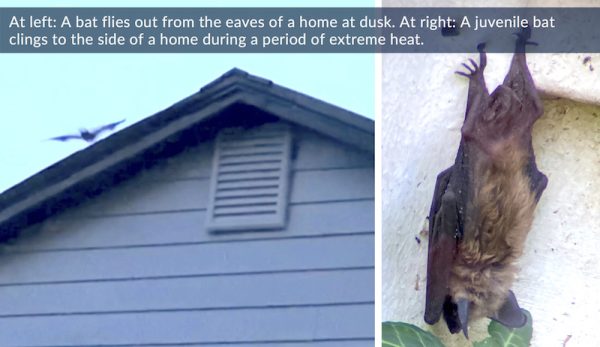
It looked like a dead leaf hanging off of the side of the bottom corner of my house. But on closer inspection, I noticed that “leaf” had tiny claws, leathery wings and downy-looking fur. I made sure all the people and pets in my house gave the juvenile bat a wide berth.
By the next morning, it had moved on.
For a few years, I’ve tolerated a small number of bats living just under the siding of my house. After all, they’ve been running out of natural habitat. What’s more, we’ve lost more than 90 percent of certain bat populations to white-nose syndrome.
While I’ve rarely seen or heard “my” bats, I’ve certainly benefitted from having them around. “They’re going to be removing insect pests from your environment,” says Brad Westrich, a mammalogist with the Indiana Department of Natural Resources Division of Fish & Wildlife. “Those may be mosquitoes that could transmit various pathogens to you or your livestock or pests in your garden or in your local forest.”
In fact, some estimate that bats save farmers nearly $4 billion in pest control services annually.
Who’s Roosting?
When it comes to finding suitable roosting spots, the big brown bat, the evening bat and the little brown bat aren’t as choosy as some of the other bat species. “They’re going to be more flexible and all right with utilizing one of those human structures,” Westrich says.
He continues, “If maintenance on the outside of a structure hasn’t been kept up, bats are going to utilize those openings … and have that nice place to roost.” Bats easily can exploit small openings created by mice or other animals. They’ll also take advantage of breaches in siding, gables and soffits from natural wear-and-tear.
Read more: Keep uninvited guests out of your barn with these tips.
Potential Problems
It’s one thing to harbor a few bats under the siding on the outside of your house, but what if they’re inside your attic?
“While they’re in the attic roosting, they’ll flip over from their hanging position, so that they can urinate and defecate,” Westrich says. “Obviously, that accumulation of moisture wouldn’t be good for insulation in the longterm.”
Bat guano may be good for the garden, but allowing it to build up indoors is a non-starter. “You can either hire a professional to remove those things or very cautiously—wearing a respirator and sealing goggles—you can remove [the guano] yourself,” he says.
(Donning personal protective equipment for these cleanup operations is essential, since the dust and debris you encounter may contain harmful pathogens.)
People & Pets
Bats can pose further risk to people and pets because they are a potential vector for rabies. “If you have pets, make sure they’re current on their rabies vaccinations,” Westrich says. “Should they have an encounter with a bat inside the structure or outside—if the bat’s clinging to the side of your house or barn—then you know that that pet is as safe as it can be.”
If there are children in your household, tell them never to touch a bat they encounter. “They shouldn’t try to pick it up,” he says. “You want to avoid those incidences when a bite could happen and then you have to deal with the hospital and worrying about getting post-exposure [rabies] prophylaxis.”
Let’s say you find a bat in your living space and you suspect you or someone else may have had contact with the animal. “In those cases, you need to go to all lengths possible to safely capture that bat and get it to your local county or state health department,” Westrich says. “If you can capture the bat and get it submitted [for rabies testing], you could get those results back quickly to prevent yourself from having to go through the post-exposure prophylaxis.
“If you don’t have the bat, then more than likely doctors are going to err on the side of caution and urge you to get it.”
The Fix
In North America, bats emerge from hibernation and begin looking for roosting structures in the spring. “If you can catch it between April and early June, you have the possibility of excluding the bats,” Westrich explains. To keep them out, you can buy one-way bat exclusion devices or make your own.
If, like me, you have a sizable bat colony and you’re already well into summer, you’ll want to wait until fall to remediate. In October, bats typically head to area caves to hibernate. Once they’ve gone, you can remove any guano, make necessary repairs and install bat excluders to keep them out next season.
Finishing Touches
Depending on the species, bats can live from five to 30 years, and, Westrich notes, “They’re going to return to some of those habitat areas for various portions of their life cycles.”
With that in mind, consider offering any returning bats some alternate digs. “That can involve putting up a bat house, either on your structure near where they were getting in and out, or putting up a bat house, at least on your property near that structure,” Westrich suggests.




